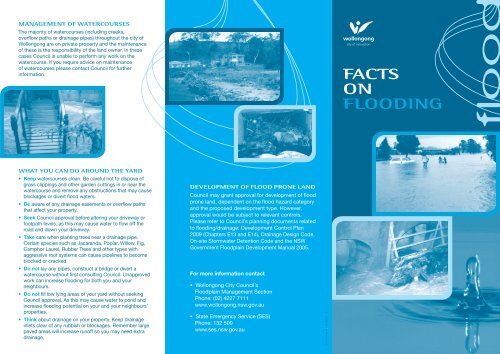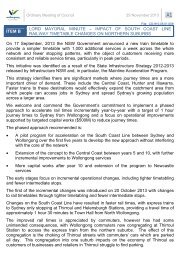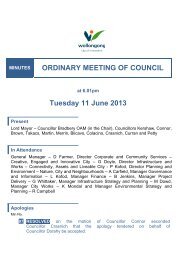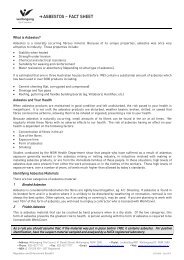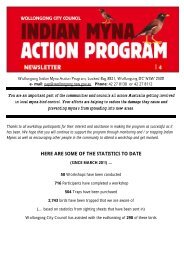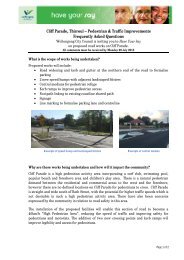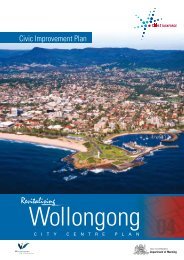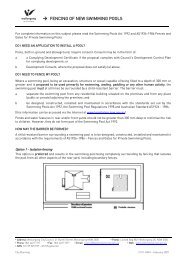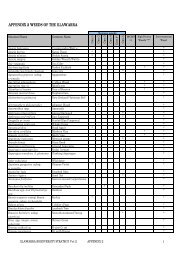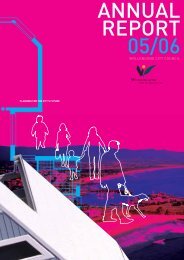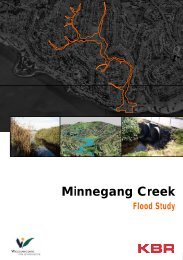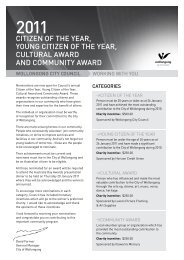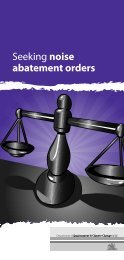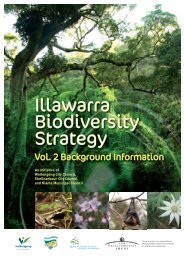Flood - Wollongong City Council - NSW Government
Flood - Wollongong City Council - NSW Government
Flood - Wollongong City Council - NSW Government
You also want an ePaper? Increase the reach of your titles
YUMPU automatically turns print PDFs into web optimized ePapers that Google loves.
MANAGEMENT OF WATERCOURSESThe majority of watercourses (including creeks,overflow paths or drainage pipes) throughout the city of<strong>Wollongong</strong> are on private property and the maintenanceof these is the responsibility of the land owner. In thesecases <strong>Council</strong> is unable to perform any work on thewatercourse. If you require advice on maintenanceof watercourses please contact <strong>Council</strong> for furtherinformation.FACTSONFLOODINGWHAT YOU CAN DO AROUND THE YARD• Keep watercourses clean. Be careful not to dispose ofgrass clippings and other garden cuttings in or near thewatercourse and remove any obstructions that may causeblockages or divert flood waters.• Be aware of any drainage easements or overflow pathsthat affect your property.• Seek <strong>Council</strong> approval before altering your driveway orfootpath levels, as this may cause water to flow off theroad and down your driveway.• Take care when planting trees near a drainage pipe.Certain species such as Jacaranda, Poplar, Willow, Fig,Camphor Laurel, Rubber Trees and other types withaggressive root systems can cause pipelines to becomeblocked or cracked.• Do not lay any pipes, construct a bridge or divert awatercourse without first consulting <strong>Council</strong>. Unapprovedwork can increase flooding for both you and yourneighbours.• Do not fill low lying areas of your yard without seeking<strong>Council</strong> approval. As this may cause water to pond andincrease flooding potential on your and your neighbours’properties.• Think about drainage on your property. Keep drainageinlets clear of any rubbish or blockages. Remember largepaved areas will increase runoff so you may need extradrainage.DEVELOPMENT OF FLOOD PRONE LAND<strong>Council</strong> may grant approval for development of floodprone land, dependent on the flood hazard categoryand the proposed development type. However,approval would be subject to relevant controls.Please refer to <strong>Council</strong>’s planning documents relatedto flooding/drainage: Development Control Plan2009 (Chapters E13 and E14), Drainage Design Code,On-site Stormwater Detention Code and the <strong>NSW</strong><strong>Government</strong> <strong>Flood</strong>plain Development Manual 2005.For more information contact• <strong>Wollongong</strong> <strong>City</strong> <strong>Council</strong>’s<strong>Flood</strong>plain Management SectionPhone: (02) 4227 7111www.wollongong.nsw.gov.au• State Emergency Service (SES)Phone: 132 500www.ses.nsw.gov.auWCC Mrktg © 1337269.3.13
<strong>Wollongong</strong> is a beautiful cityto live in, but the combinationof the steep escarpment andflat coastal plains makes itparticularly susceptible toflash flooding.Flash flooding occurswhen large amounts ofrain fall during a shortperiod period of time,causing the creek watersto rise quickly, resulting inlittle warning before waterbegins to enter homesand businesses. Becauseof this, it is importantyou are aware of yourflood risk and know whatyou can do to prepareyourself and your familyfor a flood.<strong>Flood</strong>ing is a natural hazard that affects theentire community and is something we mustall contend with. It is important to realise thatfloods can occur at any time, and that floodsbigger than any previously recorded can occur.WHAT IS COUNCIL DOING TOMANAGE FLOODING?<strong>Wollongong</strong> <strong>City</strong> <strong>Council</strong>’s responsibility is tomanage flood prone land by identifying waysto reduce the impact of flooding on thoseliving in the floodplain, as well as reducingprivate and public losses from floods.Detailed flood studies allow <strong>Council</strong> tounderstand how each catchment is affectedby flooding. Once the causes are known, a<strong>Flood</strong>plain Risk Management Plan can beimplemented to help minimise the effects.Developing and implementing these plans iscostly and time consuming, taking severalyears to complete. For more informationplease refer to <strong>Council</strong>’s website or call our<strong>Flood</strong>plain Management section on(02) 4227 7111.ARE YOU AT RISK OF FLOODING?If you live close to a creek, major stormwaterdrain or outlet, or live in a low-lying area,you may be at risk from flooding even if youhaven’t experienced a flood before.<strong>Wollongong</strong> <strong>City</strong> <strong>Council</strong> is ableto provide information on knownflood levels recorded from historicalevents and from completed floodstudies. <strong>Flood</strong> risk precincts arealso available for all adopted<strong>Flood</strong>plain Risk Managementstudies. For more information pleaserefer to <strong>Council</strong>’s website or our<strong>Flood</strong>plain Management section on(02) 4227 7111.WHAT CAN YOU DO TO PREPARE FORFLOODING?<strong>Flood</strong>ing can occur with very little warning. It’s importantto understand the extent of flood risk on your area andhow to prepare yourself before a flood occurs.There are a number of things that you can do:BE PREPARED• Find out if your home orbusiness could be affectedby flooding.• Keep emergency numbers ina safe and waterproof place.• Prepare a flood emergencykit, including portable radio,batteries, torch, first aid kit,essential medication, freshwater and tinned food, waterproof bag, candles andwaterproof matches.WHEN IT’S RAINING HEAVILY IN YOUR AREA• Listen to your local radio station and TV for warningsand advice.• Check that your neighbours know of the warnings.• If water can enter your home, stack furniture andpossessions above flood waters either on beds ortables (electrical items on top) and secure objects thatcould float and cause damage.AFTER FLOODING HAS BEGUN• Don’t drive or walk in flood waters• If you are at home, stay there until advised otherwise.• Keep listening to your local radio station.• Avoid using electrical or gas appliances.• Never eat or drink food that has been in contact withflood water.IF YOU NEED TO EVACUATE• Tell the Police, SES or your neighbours.• Turn off power, gas and water. Take your emergencykit and personal valuables with you.• Don’t forget your pets, take them with you if youevacuate.Don’t wait until it’s too late to act. Be prepared now -better ‘<strong>Flood</strong>Safe’ than sorry.


